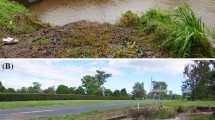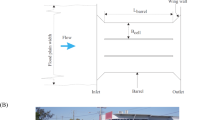Abstract
A culvert is a covered channel designed to pass water through an embankment. The recognition of the adverse ecological impacts of culverts on upstream fish passage is driving the development of new culvert design guidelines, with a focus on small-bodied fish species seeking low velocity zones to minimise energy expenditure. Herein a hybrid modelling technique was applied, combining physical modelling, one-dimensional theoretical calculation and three-dimensional computational fluid dynamics modelling. The results reveal fundamental turbulent processes that may affect small-body-mass fish navigability and provide new insights for the development of standard box culvert design guidelines. Systematic validations were performed to a wide range of initial conditions and smooth barrel geometries. A physical relationship was derived from numerical and experimental data of past and present studies, correlating the dimensionless flow area with a normalised local velocity V/Vmean.








Similar content being viewed by others
References
ANSYS® Academic Research, Release 18.0 (2017) Help System, ANSYS Fluent User’s Guide, ANSYS, Inc
Apelt CJ (1983) Hydraulics of minimum energy culverts and bridge waterways. Aust Civ Eng Trans CE25(2):89–95
Behlke CE, Kane DL, McLeen RF, Travis MT (1991) Fundamentals of culvert design for passage of weak-swimming fish. Report FHW A-AK-RD-90-10. Department of Transportation and Public Facilities, State of Alaska, Fairbanks, USA
Blank MD (2008) Advanced studies of fish passage through culverts: 1-D and 3-D hydraulic modelling of velocity, fish energy expenditure, and a new barrier assessment method. Ph.D. thesis, Montana State University, Department of Civil Engineering
Boussinesq J (1897) Essai sur la théorie des eaux courantes. Mémoires présentés par divers savants à l’Académie des Sciences 23(1):1–680 (in French)
British Standard (1943) Flow measurement. British Standard Code BS 1042:1943, British Standard Institution, London
Cabonce J, Fernando R, Wang H, Chanson H (2017) Using triangular baffles to facilitate upstream fish passage in box culverts: physical modelling. Hydraulic model Report No. CH107/17. School of Civil Engineering, The University of Queensland, Brisbane, Australia
Cabonce J, Wang H, Chanson H (2018) Ventilated corner baffles to assist upstream passage of small-bodied fish in box culverts. J Irrig Drain Eng ASCE 144(8):0418020. https://doi.org/10.1061/(asce)ir.1943-4774.0001329
Cabonce J, Fernando R, Wang H, Chanson H (2019) Using small triangular baffles to facilitate upstream fish passage in standard box culverts. Environ Fluid Mech 19(1):157–179. https://doi.org/10.1007/s10652-018-9604-x
Chanson H (2000) Introducing originality and innovation in engineering teaching: the hydraulic design of culverts. Eur J Eng Educ 25(4):377–391. https://doi.org/10.1080/03043790050200421
Chanson H (2004) The hydraulics of open channel flow: an introduction, 2nd edn. Butterworth-Heinemann, Oxford
Chanson H, Leng X (2018) On the development of hydraulic engineering guidelines for fish-friendly standard box culverts, with a focus on small-body fish. Civil Engineering Research Bulletin No. 25, School of Civil Engineering, The University of Queensland, Brisbane, Australia
Fairfull S, Witheridge G (2003) Why do fish need to cross the road? Fish passage requirements for waterway crossings. NSW Fisheries, Cronulla, NSW, Australia
Hee M (1969) Hydraulics of culvert design including constant energy concept. In: Proceedings of the 20th conference of local authority engineers. Department of Local Government, Queensland, Australia, paper 9, pp 1–27
Henderson FM (1966) Open channel flow. MacMillan Company, New York
Herr LA, Bossy HG (1965) Hydraulic charts for the selection of highway culverts. Hydraulic Engineering Circular, US Department of Transportation, Federal Highway Administration, HEC No. 5
Hirt C, Nichols B (1981) Volume of fluid (VOF) method for the dynamics of free boundaries. J Comput Phys 39(1):201–225
Jensen KM (2014) Velocity reduction factors in near boundary flow and the effect on fish passage through culverts. Master of Science thesis, Brigham Young University, USA
Khodier MA, Tullis BP (2014) Fish passage behavior for severe hydraulic conditions in baffled culverts. J Hydraul Eng ASCE 140(3):322–327. https://doi.org/10.1061/(ASCE)HY.1943-7900.0000831
Larinier M (2002) Fish passage through culverts, rock weirs and estuarine obstructions. Bulletin Français de Pêche et Pisciculture 364:119–134
Launder BE, Spalding DB (1974) The numerical computation of turbulent flows. Comput Methods Appl Mech Eng 3(2):269–289
Leng X, Chanson H (2018) Modelling low velocity zones in box culverts to assist fish passage. In: Lau TCW, Kelso RM (eds) Proceedings of 21st Australasian fluid mechanics conference, Adelaide, Australia, 10–13 December, p 547
Leng X, Simon B, Khezri N, Lubin P, Chanson H (2019) CFD modelling of tidal bores: development and validation challenges. Coast Eng J. https://doi.org/10.1080/21664250.2018.1498211
Macintosh JC (1990) Hydraulic characteristics in channels of complex cross-section. Ph.D. thesis, School of Civil Engineering, The University of Queensland, Brisbane, Australia
Naot D, Rodi W (1982) Numerical simulations of secondary currents in channel flow. J Hydraul Div ASCE 108(HY8):948–968
Nezu I, Rodi W (1985) Experimental study on secondary currents in open channel flow. In: Proceedings of the 21st IAHR Congress, IAHR, Melbourne, pp 115–119
Nikuradse J (1926) Untersuchungen über die geschwindigkeitsverteilung in turbulenten strömungen. Ph.D. thesis, Gottingen, VDI Forsch
Olsen A, Tullis B (2013) Laboratory study of fish passage and discharge capacity in slip-lined, baffled culverts. J Hydraul Eng ASCE 139(4):424–432
Quadrio J (2007) Passage of fish through drainage structures. Qld Roads (4):6–17
Roache PJ (1998) Fundamentals of computational fluid dynamics. Hermosa Publishers
Wang H, Chanson H (2018) Modelling upstream fish passage in standard box culverts: interplay between turbulence, fish kinematics, and energetics. River Res Appl 34(3):244–252. https://doi.org/10.1002/rra.3245
Wang H, Chanson H, Kern P, Franklin C (2016) Culvert hydrodynamics to enhance upstream fish passage: fish response to turbulence. In: Ivey G, Zhou T, Jones N, Draper S (eds) Proceedings of 20th Australasian Fluid Mechanics Conference, Australasian Fluid Mechanics Society, Perth, WA, Australia, 5–8 December, p 682. ISBN 978 2 74052 377 6
Warren ML Jr, Pardew MG (1998) Road crossings as barriers to small-stream fish movement. Trans Am Fish Soc 127:637–644
Xie Q (1998) Turbulent flows in non-uniform open channels: experimental measurements and numerical modelling. Ph.D. thesis, School of Civil Engineering, The University of Queensland, Brisbane, Australia
Zhang G, Chanson H (2018) Three-dimensional numerical simulations of smooth, asymmetrically roughened, and baffled culverts for upstream passage of small-bodied fish. River Res Appl 34(8):957–964. https://doi.org/10.1002/rra.3346
Acknowledgements
The authors thank Dr Matthew GORDOS and Marcus RICHES (NSW DPI Fisheries, Australia), and Professor Colin J. APELT (The University of Queensland, Australia) for very helpful discussions. The authors further acknowledge the assistance of Ms Matilda MEPPEM and Mr Tianwei YIN (The University of Queensland, Australia) in conducting a number of tests using CFD models. The financial support of Australian Research Council (Grant LP140100225) and Queensland Department of Transport and Main Roads (TMTHF1805) is acknowledged.
Author information
Authors and Affiliations
Corresponding author
Ethics declarations
Conflict of interest
Hubert CHANSON has competing interest and conflict of interest with Craig E. FRANKLIN.
Additional information
Publisher's Note
Springer Nature remains neutral with regard to jurisdictional claims in published maps and institutional affiliations.
Rights and permissions
About this article
Cite this article
Leng, X., Chanson, H. Hybrid modelling of low velocity zones in box culverts to assist upstream fish passage. Environ Fluid Mech 20, 415–432 (2020). https://doi.org/10.1007/s10652-019-09700-1
Received:
Accepted:
Published:
Issue Date:
DOI: https://doi.org/10.1007/s10652-019-09700-1




